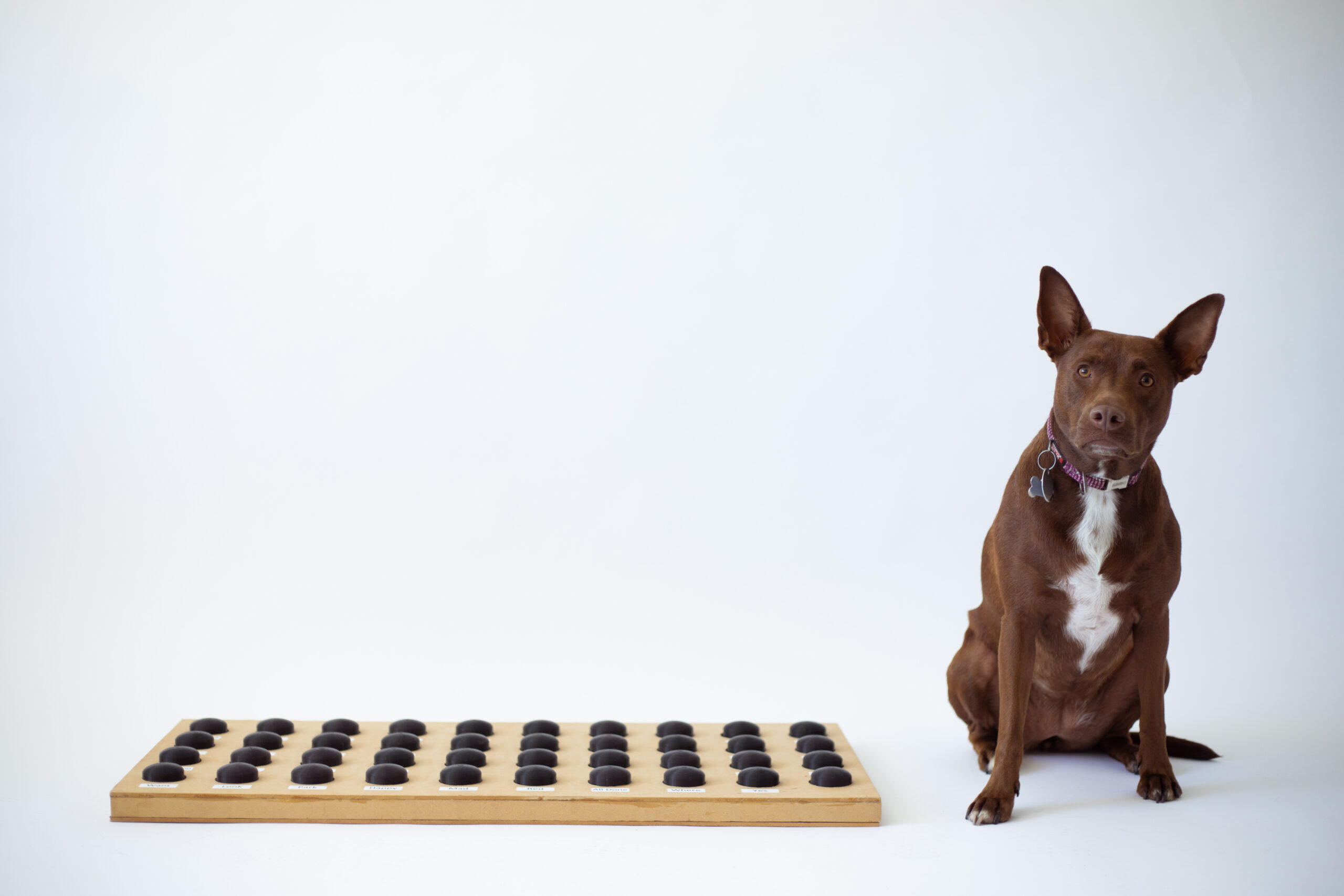One of the questions I’m asked most frequently is how to teach a new puppy to talk. Is it best to introduce buttons right away? Do puppies need to master any skills first before they can use buttons? How does teaching a puppy differ from teaching an older dog?
I have some good news for you: dogs of all ages can learn to talk, and there’s no need to wait to start teaching your new puppy. Introducing buttons to your puppy is an exciting time filled with so much potential. Puppies are naturally curious, ready to learn, and eager to be with you. Implementing button communication from the start sets your puppy up for a lifetime of reciprocal communication and deeper understanding between you and your dog.
Understanding the expectations and learning processes for puppies will help you set realistic goals and set yourself up for your best teaching success. Here’s what you need to know about teaching your puppy to use words:
Puppies have to develop receptive language skills first
In both humans and dogs, receptive language (understanding of words) comes before expressive language (using words). This means your puppy will need time to develop understanding of words before she’s able to use them on her own. Every time you say a word verbally and with your dog’s button during the appropriate contexts (“Outside” before going outside, “Play” when your dog dives on a toy, etc.) you are teaching your dog what each word means. It may take your puppy a couple of weeks to understand the words you’re using on a daily basis.
Puppies have shorter attention spans
Puppies have shorter attention spans than older dogs. By the time you have your puppy’s attention, you often only have a few seconds before they’re focused on something else in the environment. When you do have your puppy’s attention, make the most of it! Model a relevant word a few times in a row before she moves on to something else.
When she does move on, let her. It’s better to follow your dog’s lead and model words that match what she’s doing rather than trying hard to get her to pay attention to you and make her stop what she’s doing. The latter can cause more of a negative association with the buttons as they are treated more as work or an obligation rather than a tool for communication and connection. Even if it appears like your dog isn’t watching you, model words anyway that match what’s happening. Your puppy is listening to and picking up on more than you think.
Puppies need quicker response times
As puppies do have shorter attention spans, response times between saying a word and then providing the outcome should be very fast. We want to provide a quick response so your puppy develops an understanding of the correlation between saying a word and what happens in the environment around her. This is how she will learn the power of each word. Consider keeping your buttons in an area where the actions for words are easily accessible (close to the door, food / water bowls, toys, etc.).
Build words into your routines together
If you start teaching a puppy how to talk, your puppy will come to view the buttons as a very normal part of life. Buttons will have always been a tool available to them to communicate. You can really set your puppy up for long-term communication success by using words to talk about the routines you are building together. When you leave, you can say “bye” or “go,” every time you put your puppy to bed you can model the word “bed,” and can say “love you” when you’re snuggling together.
Routine-based learning is so powerful in teaching language to both humans and dogs. Dogs love routines! The more you include words in their routines, the better chance they have at learning to use them too.
Teaching Your Puppy to Talk is Different than Other Puppy Training
If you have a puppy, you’re likely doing at least some other types of training at home too, even if it’s just the simple commands of “sit” and “come.” Be mindful that teaching your puppy to use words is different from traditional training. Traditional dog training is often command-based, as you are training your dog to perform a specific action on your command. We don’t want to train our dogs to say a certain word on our command.
We want to teach authentic, purposeful communication. By modeling words in their naturally occurring contexts, giving lots of wait time and using other gentle cues such as pointing to or tapping a button from time to time, you are showing your dog how she can say that word when she wants to.
Always remember that learning takes time. Don’t rush your puppy’s learning by trying to force them to say something. Your puppy needs time to get to know you, understand what different words mean, and figure out life in a new environment. With the right teaching strategies and support, your puppy will start talking when she’s ready!
If you’re ready to teach your puppy how to talk, get started with the Talking Pet Essential Set and the Talking Pet Button Mat. The Essential Set of buttons comes with 6 pre-recorded words plus step by step activities for teaching each word. When you’re ready to expand your dog’s vocabulary or want to start with more buttons, checkout the Talking Pet Names Set and Talking Pet Locations Set. You can also track your puppy’s progress and learn what milestones to look for with the Talking Pet Goal Tracker.
Puppy Communication Essentials!


